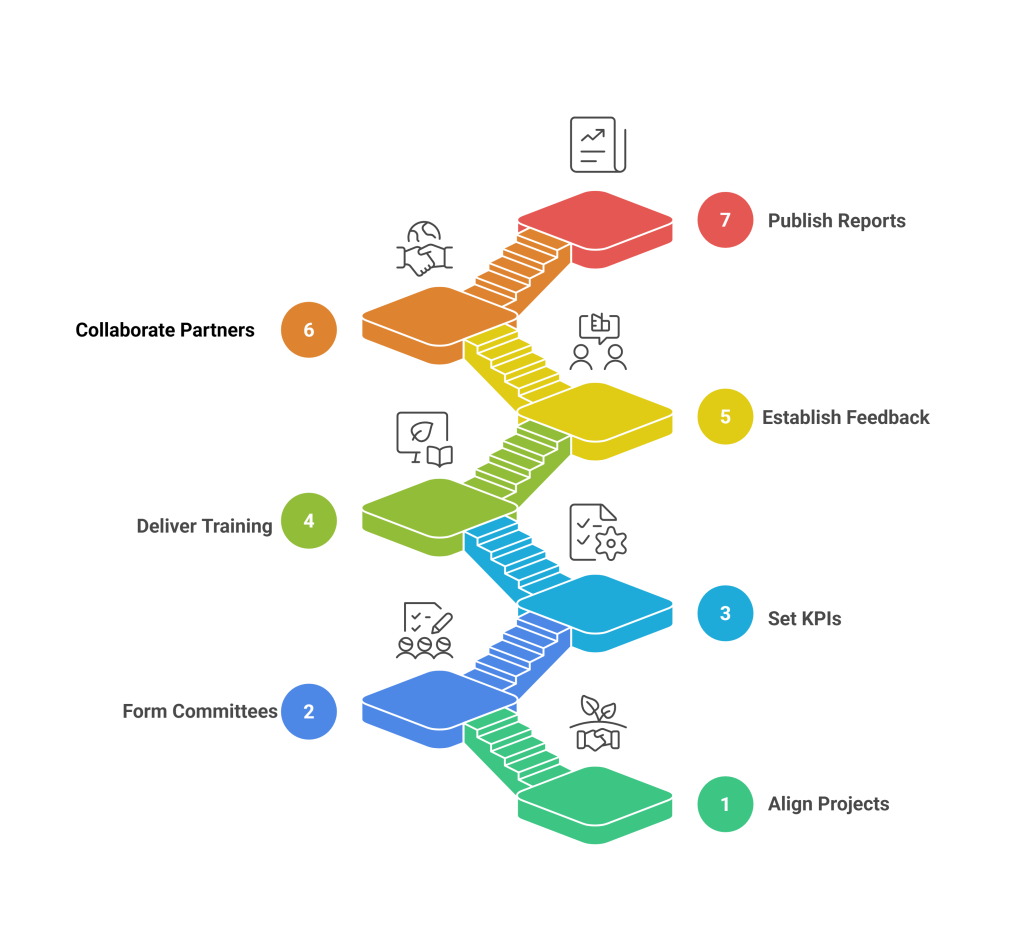
Balancing digital innovation with ethics and sustainability is the central imperative for organizations navigating the challenges and opportunities of 2025. Because technology now shapes every industry and society itself, leaders must ensure that their drive for innovation never outpaces their obligations to responsibility and environmental stewardship. As digital tools become more powerful and ubiquitous, balancing digital innovation with ethics and sustainability emerges as the foundation for trust, business resilience, and lasting value creation. Moreover, businesses that prioritize this balance outpace peers in attracting talent, meeting customer and regulatory expectations, and differentiating themselves in an increasingly values-driven marketplace.
Why Balancing Digital Innovation with Ethics and Sustainability Matters in 2025
Because every organizational activity now touches technology, companies cannot afford to innovate without robust ethical and sustainability principles. For instance, fast-evolving machine learning algorithms introduce bias, data misuse, and privacy concerns, all of which threaten stakeholder trust. Furthermore, unchecked digital transformation amplifies energy consumption and electronic waste—which, in turn, attracts new scrutiny from investors, regulators, and society. Consequently, balancing digital innovation with ethics and sustainability is now both an operational necessity and a reputational mandate.
How Balancing Digital Innovation with Ethics and Sustainability Creates Value
To deliver real progress, forward-thinking organizations embed balancing digital innovation with ethics and sustainability into their products and culture. For example, companies implementing responsible AI avoid costly bias scandals and preserve trust with their base. Additionally, building environmentally sustainable digital products—such as low-energy software or devices designed for recycling—positions brands as leaders, not laggards, in the global shift toward greener economies. Thus, simultaneously reduces risk and sparks new investment and growth opportunities.
Practical Frameworks
Given the fast pace and complexity of technological change, digital innovation requires actionable, transparent frameworks. Therefore, organizations should:

- Align every digital project with a stated ethics and sustainability vision tied to business outcomes.
- Form multidisciplinary committees, including IT, compliance, sustainability, and business experts, for project oversight.
- Set structured KPIs covering data privacy, carbon footprint, community welfare, and inclusivity.
- Deliver regular, organization-wide training on digital ethics, green best practices, and the latest regulations.
- Establish feedback mechanisms—such as anonymous reporting and open town halls—so concerns can be surfaced and addressed early.
- Collaborate with external partners, including NGOs, academic researchers, and customers, for ongoing benchmarking.
- Publish regular reports on progress and setbacks for transparency.
As a result, balancing digital innovation with ethics and sustainability moves from intention to daily reality for all staff and partners.
Leveraging Technology
Although advancing technology can introduce new risks, it also unlocks the very solutions needed for balance. Because artificial intelligence, cloud computing, IoT, and blockchain are now central parts of most business models, should always include:
- Explainable, auditable AI that can be easily reviewed for fairness and transparency.
- Multi-layered data protection (encryption, anonymization, consent management) built into every product.
- Cloud infrastructure and apps optimized for energy efficiency and powered by renewables where possible.
- Hardware choices and digital products designed for repairability, reusability, and closed-loop lifecycle management.
- Automated monitoring for compliance and carbon tracking, with dashboards accessible to executives and external stakeholders.
- Privacy-by-design principles that are applied from ideation to product launch.
By relying on rigorous supervision, third-party audits, and state-of-the-art analytics, businesses can use technology to scale both ambition and responsibility.
Building a Culture
Because people—not systems—bring frameworks to life, building a strong culture is essential. Leaders must:
- Practice and communicate ethical choices, recognizing those who champion responsible innovation.
- Incentivize teams to propose solutions that deliver both profit and positive impact.
- Celebrate “green wins,” from reduced cloud energy use to responsible supply chain initiatives, alongside financial milestones.
- Schedule ongoing workshops, simulations, and knowledge-sharing sessions, transforming every crisis and gap into opportunities for learning and resetting standards.
- Enforce accountability through clear policies but nurture trust through transparency and empowerment.
Consequently, when employees see that balancing digital innovation is a cornerstone value—not a marketing slogan—they become enablers and guardians of this mission.
Case Study
Consider a global logistics company that transformed its digital backbone in 2025. By anchoring all projects with ethics and sustainability, the company:
- Shifted its tech stack to renewable-powered cloud platforms, reducing its carbon footprint by 35%.
- Built and certified AI algorithms that guaranteed equitable delivery and routing for all neighborhoods—urban or rural, affluent or disadvantaged.
- Installed reusable and recyclable IoT sensors across its fleet and warehouses, significantly minimizing e-waste.
- Required every partner and supplier to meet rigorous codes for labor, privacy, and green practices.
As a result, the logistics leader not only saved millions on operations but also won unprecedented public sector tenders, improved brand sentiment, and built a loyalty loop with customers and staff rooted in transparency and trust.
Overcoming Challenges
Admittedly, navigating this balance brings real obstacles. Rapid innovation uncovers new ethical risks, legacy tech stacks may resist integration, and global regulatory models add layers of complexity. Nevertheless, companies succeed when they:

- Pilot cross-disciplinary innovation teams to anticipate, test, and remediate potential issues early.
- Institute “ethics sprints” in every agile cycle—short bursts dedicated to reviewing projects for red flags and alignment.
- Create or join consortia for up-to-date benchmarking, pooling resources, and open sharing of learning.
- Publicly address and correct missteps, turning setbacks into credibility and resilience builders.
- Invest in building skill-bridges between developers, sustainability leaders, and compliance officers.
With every hurdle overcome, organizations deepen the capacity and speed with which they deliver responsible progress.
Industry Trends
As heightened scrutiny and opportunity converge, several trends define what’s next:
- Government mandates for AI explainability, fairness testing, and real-world social impact audits are accelerating.
- Sustainability reporting for digital operations—using blockchain and IoT—has become a prerequisite for entry into government and multinational contracts.
- Circular economy standards are more common, with companies voluntarily certifying devices and processes for ethical sourcing, durability, and recyclability.
- Investors now tie capital allocation to enterprise ESG (Environmental, Social, Governance) performance, demanding regular digital accountability metrics.
- Inter-sector coalitions—pairing public, private, and academic institutions—are setting and evolving global best practices for digital responsibility and transparency.
Because external and internal forces alike reward companies who lead in balancing digital innovation with ethics and sustainability, laggards find themselves squeezed out by both regulation and public opinion.
Conclusion
In 2025 and beyond, balancing digital innovation with ethics and sustainability is no longer a slogan but the very basis for trust and lasting value. Only organizations that weave responsibility and environmental care into every system, partnership, and strategy can thrive sustainably in an increasingly demanding digital era. Therefore, making balancing digital innovation with ethics and sustainability integral to your enterprise not only drives compliance but unlocks limitless possibility for growth, trust, and positive impact.
FAQ
Why is balancing digital innovation with ethics and sustainability the defining challenge of the digital age?
Because unchecked technology can do as much harm as good, and only leaders who balance ambition with accountability earn trust, loyalty, and long-term success.
How can companies ensure digital products and services align with these principles?
By adopting ethical design standards, setting explicit balance-focused KPIs, recruiting diverse stakeholder input during every product phase, and using transparent, automated reporting.
Are there measurable business benefits?
Yes—risk reduction, faster regulatory clearance, brand thermals, customer preference, and even higher operating margins as internal waste and inefficiency are addressed.
Can speed and innovation coexist with these priorities?
Absolutely. Companies that embed checkpoints and agile, integrated governance actually iterate faster and with fewer costly surprises post-launch.
What’s the role of technology itself?
Beyond the risks, technology is the ultimate enabler—delivering advanced analytics, traceable supply chains, and energy efficiency—all while keeping people and the planet at the center.

